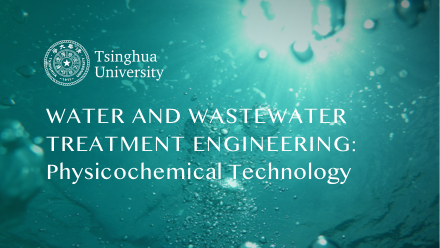
当前课程知识点:Water and Wastewater Treatment Engineering: Physicochemical Technology > Chapter 2 Sedimentation and clarification > 2-7 Vertical Flow (up-flow ) and radial flow settling tank > 2-7 Vertical Flow (up-flow ) and radial flow settling tank
返回《Water and Wastewater Treatment Engineering: Physicochemical Technology》慕课在线视频课程列表
返回《Water and Wastewater Treatment Engineering: Physicochemical Technology》慕课在线视频列表
同学们好!在这一节里我们介绍竖流式沉淀池和幅流式沉淀池
首先介绍竖流式沉淀池,顾名思义,竖流式沉淀池就是水流在沉淀池中竖向流动
下面我们来看看竖流式沉淀池的构造
竖流式沉淀池在平面上可以设计成圆形、方形或多边形,但大部分为圆形
这是圆形竖流式沉淀池的一个演示动画
大家可以看到,原水由中心管下口流入沉淀池内,通过反射板的拦阻
向四周分布于整个沉淀区水平断面上,然后水流再缓慢向上流动
因此,在竖流式沉淀池中,水流方向是向上的,与颗粒向下的沉淀方向相反
沉淀后的水通过设在周边的堰口溢出,经集水槽收集后排出
而沉淀下来的颗粒直接落入底部污泥斗,靠静水压力由排泥管排出
在竖流式沉淀池中,要使水流较稳定,接近竖流
对沉淀池的径深比就有一定的要求
直径与沉淀区深度的比值一般不宜超过3,而直径一般不宜超过10m
下面我们来看看在竖流式沉淀池中颗粒沉降具有什么特征?
在竖流式沉淀池中,颗粒沉速的方向是往下的,而水流上升速度往上
当颗粒发生的是自由沉淀时
只有沉速大于水流上升速度的颗粒才能下沉到沉淀池池底被去除
因此,竖流式沉淀池沉淀效果一般比平流式沉淀池和幅流式沉淀池的低
对于絮凝沉淀,上升的小颗粒和下沉的大颗粒之间相互接触,发生絮凝作用
使粒径增大,从而使沉速加快
在竖流式沉淀池中,水流上升速度v的确定非常重要
它不能大于设计的颗粒截留速度u
而颗粒截留速度可以通过沉淀实验求得,如果没有沉淀实验资料
可以采用经验值,对于生活污水v可采用0.5-1.0 mm/s
对于竖流式沉淀池,沉淀池的沉淀效率等于1-p0
其中p0是沉速小于颗粒截留速度u的颗粒所占的比例
在分析竖流式沉淀池中,颗粒沉降特点基础上,我们就可以进行工艺计算
首先根据确定的竖流式沉淀池上升区流速v得到沉淀区面积f2
然后进一步计算沉淀池面积A
这里我们需要注意的是,沉淀池面积不仅包括沉淀区面积,也应包括进水中心管面积
然后就可以得到沉淀池直径D
进一步由停留时间t,来确定竖流式沉淀池的有效水深H
竖流式沉淀池的特点是排泥方便、占地小,同时管理也方便
但池深较大,沉淀效果也较差,通常适用于中小型水和污水处理厂
刚刚介绍了竖流式沉淀池,下面我们继续介绍幅流式沉淀池
幅流式沉淀池一般呈圆形或正方形,一个主要特征是直径较大
一般直径在20-30米左右,直径与有效水深之比一般为6-12
在幅流式沉淀池中,水流的流态为辐射式
根据进水方式的不同,我们有中心进水和周边进水两大类幅流式沉淀池
下面我们先来看看中心进水幅流式沉淀池的结构
大家可以看到,在沉淀池的中心设有进水中心管,原水从沉淀池的底部进入中心管
或者也可以用明渠从沉淀池的上部进入中心管
中心管周边是由穿孔挡板围成的进水区,使原水沿圆周方向均匀分布
向四周辐射流动,进入沉淀区
沉淀以后的出水从周边出水堰溢出,经集水渠收集后排出
为了阻挡漂浮物质,出水堰前端可加设挡板及浮渣收集与排出装置
刚才介绍的中心进水幅流式沉淀池,大家可以看到
由于中心进水断面比较小,进水不易均匀分布
为了改善进水的均匀性,后来发展出了向心幅流式沉淀池
在向心幅流式沉淀池中,原水从沉淀池周边进入,从中心部位,大约在R/4、R/3或R/2的部位出水
形成了这种由周边进水中心出水的向心幅流式沉淀池
也可以把出水的位置设置在沉淀池周边,形成周边进水周边出水的向心幅流式沉淀池
这个图就是这种形式的幅流式沉淀池,大家可以看到
最外圈渠道的水是浑浊的,为进水渠,而里圈的水是清澈的,是出水渠
向心幅流式沉淀池与普通的中心进水幅流式沉淀池相比,具有以下的特点
由于进水渠沿周边设置,进水断面比较大,因此入水比较均匀
沉淀池容积利用效率得到提高
另外表面负荷比中心进水幅流式沉淀提高约1倍
幅流式沉淀池大多采用刮泥机来进行刮泥
在刮泥机上安装有一定倾斜角度的刮板,当刮泥机按顺时针方向缓慢转动时
刮板就会把沉淀到池底的污泥,从最外圈逐级传递到沉淀池的中心泥斗
最后利用静水压力或污泥泵将污泥排出
刮泥机一般是一种桁架结构,绕中心旋转
刮泥机的驱动设备可安装在沉淀池中心或周边
当沉淀池直径小于20m时,一般采用中心驱动
而如果沉淀池的直径比较大,大于20m时,可以采用周边来驱动
在幅流式沉淀池中,颗粒的沉淀轨迹跟前面介绍的平流式和竖流式都不同
下面我们以中心进水周边出水幅流式沉淀池为例,来进行分析
大家从这个图可以看到,水从中心管进入以后往四周辐射流动
过水断面是变化的,因此,水流速度v是由大变小的
而颗粒向下的沉速u在沉淀过程中是不变的
因此,颗粒在幅流式沉淀池中的沉淀轨迹是一个抛物线
那么对于这样一个具有抛物线沉淀轨迹的沉淀过程,我们该如何进行计算呢?
我们先来看颗粒在幅流式沉淀池中的沉淀分离条件
假设某一个颗粒处于沉淀池进水断面的顶部A点,经过停留时间t
可以下沉到沉淀池底部B点,正好能够完全被去除
这个颗粒具有的沉淀速度,就是截留沉速u
该颗粒沿径向方向从r1移动到R,而在深度方向移动了H
这两个方向所需要的时间都应等于停留时间
但由于在这个过程中水流速度是变化的,因此需要通过积分才能进行计算
通过公式整理,最后得到截留沉速的计算式,如这个公式所示
实际上也是等于幅流式沉淀池的处理水量除以沉淀面积,也就是等于表面负荷
从以上推导,我们可以看到
尽管在幅流式沉淀池中颗粒的沉淀轨迹与平流式沉淀池不同
但计算原理是完全一样的
因此在工艺设计中我们首先根据实验数据或经验值
确定颗粒截留沉速u或表面负荷q,然后计算沉淀池沉淀面积
再根据停留时间,来确定沉淀池有效水深
辐流式沉淀池的特点是运行可靠、机械排泥设备已定型化,管理方便
但设备较复杂,对施工质量要求高,通常适用于大、中型废水处理厂
可以用作废水处理厂的初次沉淀池或者二次沉淀池
今天关于竖流式沉淀池和辐流式沉淀池就介绍到这儿,谢谢
-0-2 Water treatment process
-0-3 Wastewater treatment process
--0-3 Wastewater treatment process
-Chap 0 Homeworks
-1-1 Introduction
-1-2 Properties of colloids
-1-3 Mechanisms and process of coagulation and flocculation
--1-3 Mechanisms of coagulation and flocculation
-1-4 Coagulant and coagulant aids
-- 1-4 Coagulant and coagulant aids
-1-5 Kinetics of coagulation and flocculation
--1-5 Kinetics of coagulation and flocculation
-1-6 Factors affecting the coagulation performance
--1-6 Factors affecting the coagulation performance
-1-7 Facilities for coagulation and flocculation
--1-7 Facilities for coagulation and flocculation
-Chapter 1 Homeworks
-2-1 Introduction
-2-2 Discrete particle settling
--2-2 Discrete particle settling
-2-3 Flocculent settling
-2-4 Zone settling
-2-5 Rectangular settling tank
--2-5 Rectangular settling tanks
-2-6 Process calculation of rectangular settling tanks
--2-6 Process calculation of rectangular settling tanks
-2-7 Vertical Flow (up-flow ) and radial flow settling tank
--2-7 Vertical Flow (up-flow ) and radial flow settling tank
-2-8 Plated sedimentation tank
--2-8 Plated sedimentation tank
-2-9 Clarification pool
-3D interactive demonstration for settling tanks
-Chapter 2 Homework (part 1)
-Chapter 2 Homework (part 2)
-3-1 Introduction
-3-2 Theoretical foundation of air floatation
--3-2 Theoretical foundation of air floatation
-3-3 Pressurized dissolved air flotation
--3-3 Pressurized dissolved air flotation
-Chapter 3 Homework
-4-1 Introduction
-4-2 Structure and process of conventional rapid filter
--4-2 Structure and process of conventional rapid filter
-4-3 Water head loss of filter
--4-3 Water head loss of filter
-4-4 Filtration method of filter
--4-4 Filtration method of filter
-4-5 Filter media
-4-6 Water distribution system
--4-6 Water distribution system
-4-7 Filter backwashing
-4-8 Siphon filter
-4-9 Gravity valveless filter
--4-9 Gravity valveless filter
-4-10 Movable hood filter
-3D interactive demonstration for filtration tanks
--Usage and description for 3-D demonstration
-Chapter 4 Homework
-5-1 Introduction
-5-2 Influence factors of disinfection
--5-2 Influence factors of disinfection
-5-3 Chlorine disinfection
-5-4 Chlorine dioxide disinfection
--5-4 Chlorine dioxide disinfection
-5-5 Ultraviolet disinfection
--5-5 Ultraviolet disinfection
-Chapter 5 Homework
-6-1 Ion-exchange resin
-6-2 Properties of ion-exchange reactions
--6-2 Properties of ion-exchange reactions
-6-3 Properties of cation exchange resin
--6-3 Properties of cation exchange resin
-6-4 Properties of anion exchange resin
--6-4 Properties of anion exchange resin
-6-5 Softening system using ion exchange
--6-5 Softening system using ion exchange
-6-6 Desalination system using ion exchange
--6-6 Desalination system using ion exchange
-6-7 Ion-exchange equipment
-6-8 Treatment of industrial wastewater by ion-exchange method
--6-8 Treatment of industrial wastewater by ion-exchange method
-Chapter 6 Homework
-7-1 Introduction
-7-2 Principle and characteristics of electrodialysis
--7-2 Principle and characteristics of electrodialysis
-7-3 Configuration of electrodialysis unit
--7-3 Configuration of electrodialysis unit
-7-4 Operating parameters for electrodialysis unit
--7-4 Operating parameters for electrodialysis unit
-7-5 Principle and process of reverse osmosis
--7-5 Principle and process of reverse osmosis
-7-6 Operating parameters for reverse osmosis
--7-6 Operating parameters for reverse osmosis
-7-7 Principles and characteristics of UF and MF
--7-7 Principles and characteristics of UF and MF
-7-8 Design of ultrafiltration and microfiltration process
--7-8 Design of ultrafiltration and microfiltration process
-Chapter 7 Homework
-8-1 Fundamental knowledge and classification
--8-1 Fundamental knowledge and classification
-8-2 Ozonation
-8-3 Photo-catalytic oxidation
--8-3 Photo-catalytic oxidation
-8-4 Supercritical water oxidation
--8-4 Supercritical water oxidation
-8-5 Electrolysis
-Chapter 8 Homework
-9-1 Introduction
-9-2 Adsorption equilibrium and adsorption isotherm
--9-2 Adsorption equilibrium and adsorption isotherm
-9-3 Adsorption breakthrough curve
--9-3 Adsorption breakthrough curve
-Chapter 9 Homework



